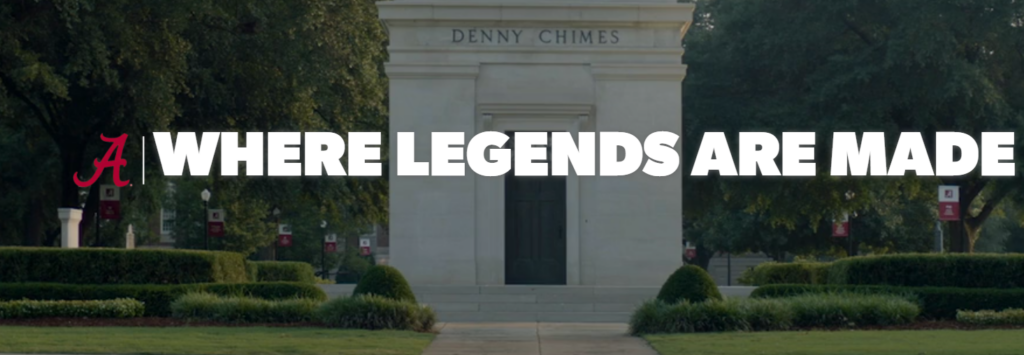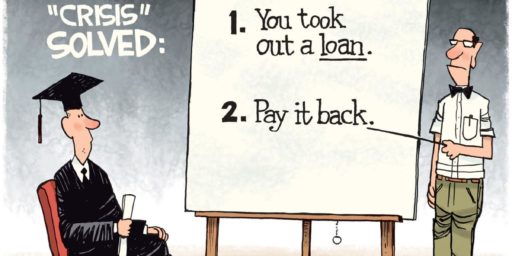Alabama, Disney, and the Quest to Be a National University
The cost of raising a university's profile.

Wall Street Journal education reporter Josh Mitchell has a new book coming out titled The Debt Trap: How Student Loans Became a National Catastrophe.
Here’s the publisher‘s blurb:
In 1982, a new executive at Sallie Mae took home the company’s financial documents to review. “You’ve got to be shitting me,” he later told the company’s CEO. “This place is a gold mine.”
Over the next four decades, the student loan industry that Sallie Mae and Congress created blew up into a crisis that would submerge a generation of Americans into $1.5 trillion in student debt. In The Debt Trap, Wall Street Journal reporter Josh Mitchell tells the untold story of the scandals, scams, predatory actors, and government malpractice that have created the behemoth that one of its original architects called a “monster.”
The tale begins in 1957 with the launch of Sputnik. Afraid that America was falling behind the Soviets in science education, Congress created the first major federal student loan program to enroll more students in college. What followed were a series of well-intentioned government actions that created a cycle of reckless lending and runaway tuition. Easy access to loans allowed colleges to raise tuition to unheard of levels, which in turn led Congress to increase loan limits and interest rates and expand who could borrow. This spiral continued as the private banks that fronted the money made huge profits on interest. “Nobody was pure in this business,” one former college president said.
As he charts the gripping seventy-year history of student debt in America, Mitchell never loses sight of the countless student victims ensnared by an exploitive system that depends on their debt. Mitchell also draws alarming parallels to the housing crisis in the late 2000s, showing the catastrophic consequences student debt has had on families and the nation’s future. Mitchell’s character-driven narrative is required reading for anyone wanting to understand the central economic issue of our day.
The Atlantic features an excerpt focusing on my graduate alma mater titled “A Crimson Tide of Debt” with the ominous subhed “Instead of propelling students into the middle class, many public institutions such as the University of Alabama are leaving them saddled with large loans.” It focuses on the case of a particular student from a lower socioeconomic background but what I find interesting is the larger business model. Much of what’s contained in the piece was known to me generically but Mitchell’s distillation is illuminating.
The University of Alabama had a meticulously groomed campus and stately redbrick buildings whose white colonnades conveyed scholastic gravitas. It had the championship-caliber Crimson Tide football team and legendary game-day tailgating with students swilling beer on fraternity-house rooftops. It featured amenities such as a state-of-the-art recreation center with a climbing wall and a “lazy river” pool complex with a 30-foot water slide. Fraternities hosted world-class rock concerts. A campus dining hall served steak cooked to order.
Everything on campus—including the student tour guides dressed in red polo shirts, riding around with parents in the back of golf carts, and the tulips carefully arranged at the school’s main entrance—was designed to appeal to young students like Thomas and their parents.
We’ll come back to this but Steven Taylor and I have commented on this trend many times before: one of the things driving up tuition costs is this massive investment in educationally irrelevant infrastructure that’s designed to attract students from well-heeled families. Much more on that later.
Until 2000, Alabama was known more for its game-day parties than academics. Faculty felt underpaid. School leaders deferred repairs or upgrades to campus facilities while downsizing or eliminating departments. Asking the state legislature for more money was a long shot; Alabama was one of the poorest states in the U.S.
This highlights a second factor we’ve both highlighted: the decreasing investment by state government into higher education. Most state universities across the country have been decreasing the share of the cost they are paying, a function of increasing costs elsewhere (pensions, prisons, police, etc.) and the inability to raise taxes.
A generation ago, public colleges such as Alabama received the large majority of their funding from state legislatures and were thus relieved of the need to charge students high tuition. As late as 1980, the money that public colleges received from student-paid tuition made up only a fifth of their revenues, on average.
Over the years, the responsibility of paying for public college shifted from state governments to students. By 2019, tuition dollars made up nearly half of all money state colleges collected each year.
Colleges such as Alabama say they have been forced to raise tuition because state governments cut direct funding of schools. During the 2007-09 recession, state governments radically reduced funding for higher education in order to deal with a severe drop in tax receipts. But many state colleges have raised tuition even when times have been good and state funding has been stable or increasing.
So, why are they doing it? In many cases, simply because they can. More on that shortly. But, also, because there’s an inexhaustible demand for more money.
The state legislature had for years rejected the university’s requests for big funding increases. Witt concluded that he had to raise tuition and expand the student body. The more students the school enrolled, the more money it would make.
Witt and Bonner came up with a strategy. Alabama didn’t have enough college-eligible in-state students, so they’d expand the pool of applicants by recruiting from outside the state. The university at the time had about 19,500 students, three-quarters of them from the state. Not only would Witt and Bonner expand the number of applicants; they’d recruit students who would pay far more than those who had come from Alabama. The school, like most state flagships, charges much higher tuition—up to three times higher—for out-of-state students. Many of those students would pay that tuition through student loans. And because the federal government had capped how much undergraduate students could borrow, many parents had to take out loans too.
The strategy changed the university’s identity. Its leaders abandoned the school’s role as a state flagship whose main mission was to teach in-state students and give an economic lifeline to the poor from rural areas. Instead, it became a regional, and eventually national, franchise.
Witt looked at what national elite universities were charging and determined that Alabama was underpriced. His first year, he raised tuition by $1,000. “We didn’t approach what we’d charge from a particularly sophisticated level,” Witt says. “We increased it $1,000. It was a fairly significant percentage increase. Applications and acceptances continued to go up. We basically systemically started taking it up $1,000 a year. Our thinking was If we begin to notice a softening in applications, acceptances, and/or matriculation, we’ll know that we need to start backing off a little.” That never happened.
For Alabama, this started almost twenty years ago now. Currently, in-state students pay $5390 and out-of-state students pay $15,125 per semester—$10,780 and $30,250 a year—in tuition alone. That doesn’t include various mandatory fees or books, much less room, board, transportation, and other expenses. When Witt started this practice in 2003, out-of-state students paid $9500 a year—or less than in-state students pay now.
Raising tuition was one prong in the strategy. Witt and Bonner also had to geographically broaden the student body to get prospective students from around the country to pay attention to Alabama and apply.
Witt foresaw a domino effect. Recruiting out-of-state students would beget more out-of-state students. Once someone from, say, Oregon committed to Alabama, they’d tell their friends or younger siblings, who would then be more likely to apply. Alabama hired three dozen recruiters stationed all over the country.
“We worked very hard to not only recruit students aggressively, but to recognize that to the right or left of that student is a parent or parents, and you need to recruit them also,” Witt says. “You need to, in effect, recruit the high-school counselors who advised many of these students. And you need to put together a field of recruiting operations that needs to be managed exactly the way you manage a field-sales organization.”
So, two things are going on here.
First, this radically changes the student body. This is arguably a good thing, indeed, if you’re trying to build a nationally-ranked university. But, if you’re an Alabama taxpayer—or an Alabama parent hoping to send your kid to the Capstone—it means the state’s flagship university is mostly educating kids who won’t be living in or paying taxes in Alabama upon graduation.
Second, this is a version of “it takes money to make money.” That is, while the university is doubtless bringing in more revenue under this strategy, it’s also eating up a significant amount in paying for this recruiting infrastructure.
Relatedly, do you recall the educationally irrelevant infrastructure I referenced earlier?
Witt transformed the university into a wonderland of higher education, and not in a figurative sense: He used Disney World as a model. Research indicated that many families decided whether to apply to a school within 20 minutes of arriving on its campus. First impressions were everything. Witt concluded that the grounds had to be pristine. He hired a retired Air Force colonel whom he sent to Disney World to study how the theme park managed its grounds.
When Witt went recruiting in wealthy enclaves in the Northeast, he discovered that many prospects had their own bedroom, not shared with siblings. He believed he needed to cater to those students by building dorm-room suites. The university built 10 residence halls during Witt’s tenure, along with the new recreation center, new academic buildings, and a baseball field, and expanded the football stadium. A new building opened every 90 days.
Again, it makes perfect sense. If you’re trying to attract the kids of the upper-middle-class and wealthy. you need to cater to their expectations. But we’re creating four-star accommodations rather than anything most of us over 40 remember as “dorm rooms.”
The university didn’t just want to increase the student body. It also wanted to attract students with strong academic credentials—high SAT and ACT scores—who tended to come from wealthier families. Those students would raise the university’s national profile and ranking.
But those students were also hard customers to land. The University of Alabama needed to have exactly the right pitch to lure them in and close the deal.
So the university did what more and more schools had quietly started to do since the early 2000s. It turned to consultants who specialize in tailoring tuition for individual students. Specifically, a consultancy by the name of Ruffalo Noel Levitz, which plugs student data into algorithms that cough out custom-made tuition plans—one of a half-dozen firms in a cottage industry known as “enrollment management.” These firms, largely unknown to the public, set the true price of college tuition, using a calculus hidden to applicants.
The industry emerged in the 1970s. At the time, colleges faced a crisis on two fronts: a demographic slowdown and the end of the Vietnam War. Fewer customers meant fewer tuition dollars. Colleges had to get creative about tuition in order to extract more money from those who did enroll. Consulting firms cropped up to help them do that.
There’s more in the piece but you get the idea. Regardless, the university has achieved its goal: despite radically increasing the size of the student body and the cost of attendance over the last two decades, Alabama has moved up the national rankings and has ratcheted up its average SAT scores to elite school levels.
Not mentioned in this piece but I would attribute some of this to the arrival of Nick Saban as the head football coach in 2007. The school has won six national championships over that span and been in the running for several more. That absolutely raises the school’s reputation and attractiveness to would-be students.
Also unstated in the piece is the influence of the US News university rankings. Metrics like SAT, national reputation, faculty salary, and endowment heavily influence a university’s position. This naturally incentivizes competition to move up the rankings and, again, Alabama has successfully moved up the ladder. While the state’s poverty and the shadow of George Wallace hang over the institution and preclude it breaking into the upper tier anytime soon, it’s far more prestigious a brand than it was two decades ago.






Great countries invest in their future. We don’t.
But remember, we can’t possibly do anything to help people drowning in this debt because that would give people without such debt a sad.
The university system in this country is broken but Alabama is not a good example for this. In fact, Alabama has become a world class institution and its pricing structure is just not that outrageous. I have noticed that most state flagship institutions do all right and are not the reason for ongoing profligacy. Blame goes to private institutions who want to be like Harvard. Here is a suggestion to stop the ongoing spiraling of tuition costs. Allow private bankers back into lending again but allow students to discharge the debt in case of bankruptcy, that will make lending more like the real world instead of just a giveaway.
The student loan bubble has been pointed out as a danger many time before.
The main reason mortgages exploded, and anyone without a credit history or collateral could get one, was that financial firms made securities out of such loans (collateralized debt obligations, or CDOs). It seems this is going on with student loans as well.
the reason the mortgage CDOs crashed, was the fall in housing prices, as well as the inability by many subprime borrowers to pay the actual interest rates installments once they couldn’t refinance their loans due to the drop in housing prices.
This is a gross oversimplification, and I’ve no idea what it implies for student loan debt.
Having the government condone it, repay it entirely, or helping to repay it, are all becoming necessary options. But the problem will persist if the loans themselves persist unchanged.
I wonder, do these universities that raise tuition all the time make a profit for someone? I can’t conceive why else they’d persist in the practice.
If the market clearing price for a college education is $25000, subsidizing a loan without any other controls will just cause the market clearing price to become $50000.
While we address the funding problems, we also need to address the fact that the universities face no pressure to control costs.
Between the fashionable dorms to attract the well-heeled and the increasing crowd of Assistant Deans and other administrative staff which have nothing to do with teaching, it’s no wonder the price keeps going up.
When I was in grad school many many years ago, tuition was roughly $2k/semester and since I was in STEM, I had a graduate stipend.
@wr:
UBI would solve this problem
@Raoul: While I’m sure that private bankers would be happy to be allowed back into the system, I think you may be missing the synergistic elements that all need to work together that will discourage them from doing anything other than buying guaranteed student debt.
In what you’re suggesting, fewer total students will chase fewer loans. But fewer students chasing fewer loans will also mean fewer total university graduates. This will lower the threshold for employment back to high school diploma level. Employers will also lose the leverage they have at the moment to demand higher educational levels in new hires. The worst case scenario will leave us with semi-skilled laborers demanding higher than minimum wages and workers across all labor cohorts demanding livable wages. How will we create the next generation of trillionaires in such an economically suffocating environment?
@Kathy: A lot of the money goes into over head. I remember while I was in Korea that someone sent me a link to an article about the University of Washington seeking to hire a new Chancellor. One of the trustees, upon being asked if the process was going to change from the previous time, said that one of the things that was going to be different was that the university was not going to offer a starting salary 20 times larger than what the governor of the state makes and they were going to remove the percentage of gross revenue increase bonus. (I subsequently checked. Yes the guy who was leaving made ~$5 million in base salary and got a bonus for raising enrollment–or tuition since it was based on increased gross revenue.
James,
I believe you are a fan of Malcolm Gladwell’s podcast, but if you haven’t caught this season’s first two episodes regarding US News & World’s rankings I would recommend you do so. Good supplemental, tangential information to the The Debt Trap.
https://www.pushkin.fm/episode/lord-of-the-rankings/
@Neil J Hudelson: I listened to it not too long ago and thought it interesting. But Gladwell seemed to be deliberately obtuse about the nature of prestige for a McDill grad who has spent the bulk of his professional career at The New Yorker. Nobody has ever claimed that Harvard and Princeton and Stanford were teaching schools aimed at first-gen, underprivileged kids. And Dillard isn’t the best HBCU in New Orleans, let alone a great national university.
@Just nutha ignint cracker:
Thanks, that answers one question.
@Neil J Hudelson:
@James Joyner:
I started listening to that episode a few weeks ago, and I lost patience for some reason. I can’t quite recall why, perhaps one too many tangents. Instead I went through Sebastian Major’s critique of “Guns, Germs, and Steel.”
@James Joyner: w00t! Xavier!
@Jon: Yup. Xavier is a terrific school. And is pretty well ranked by US News, despite the real flaws in the methodology.
@Kathy:
Which, IIRC, was a vast improvement over the actual “book.” Once again proving that editors ruthlessly editing are a valuable resource. From what I remember, there was a reasonable 325 page book struggling to escape the dust jacket on my copy.
@flat earth luddite:
Major made a really good case that Diamond’s book left plenty out. Such as the nature of the Inca forces Pizarro came across, or the fact that Cortez gathered a large army of subject peoples who had had it under Aztec domination.
Oh, and the whole of India.
@Kathy: I give Diamond a lot of credit for making the larger point – human civilization is a product of what is given them vs. some sort of racial hierarchy.
That thinking was revolutionary at the time.
@Tony W:
Silk though… she’s just riding on Diamond’s coat tails.
@Tony W:
Oh, Diamond made many good points. The steel weapons and armor of the Europeans mattered a great deal, and so did the mass killing the germs they carried accomplished. The situation Pizarro found in South america, for instance, was partly a result of the plagues that ravaged the region. But he also ignored many other contributing factors.
As popularization, his book is with a great deal of merit. But far from the grand unified theory of history some make it out to be.
@Kathy:
I saw an interesting analysis once that took it another step back: why wasn’t there a corresponding “South America pox” that ravaged Europe once the two were in contact?
The argument was that infectious disease was much more common in Europe because of 1) much larger cities that spread diseases around much more effectively and 2) much larger number of domesticated animals that increased the occurrence of animal to human jumps.
Further more, those much larger cities were also only possible because of the much larger number of domesticated animals to transport stuff in and out, so #1 is actually an extension of #2, and what really doomed the New World Empires was the lack of any domesticatable mega-fauna comparable to the horse or the cow.
@grumpy realist: Those assistant deans, and administrative staff, are who enable professors to actually teach, given the amount of work that has been offloaded to university systems (and professors) by all these technological “improvements.” I hate to sound old, but ordering classes used to be slotting in your courses on a piece of paper and sending it to the Dean’s office. Now there are not one but three systems that don’t talk to each other and have to be updated… and where in hell does anyone think a professor who’s already supposed to be publsihing and teaching and researching going to learn these systems?
@Stormy Dragon: I think syphilis could be considered your “South American Pox” that infected Europeans after Columbus returned to Spain. Which was returned to America and led to the Tuskegee Syphilis Study. And that history caused many in the Black community to be suspicious of the Covid19 vaccine, causing more deaths in that community. Syphilis, the gift that keeps on giving.